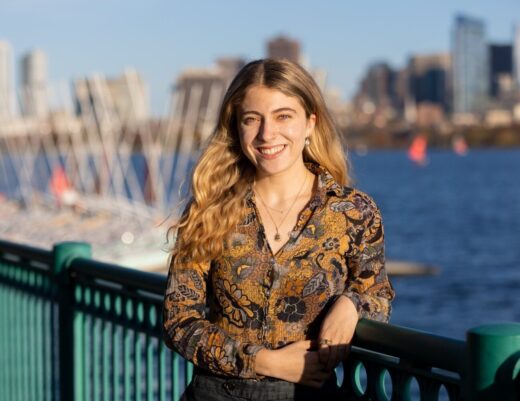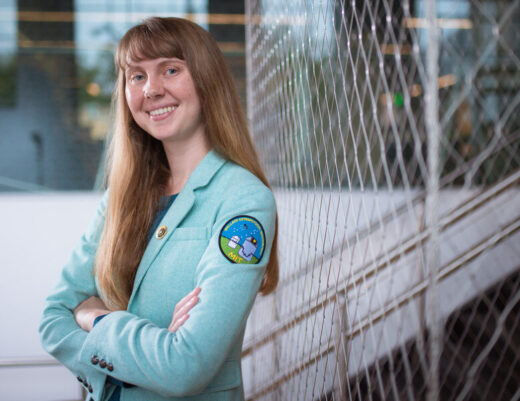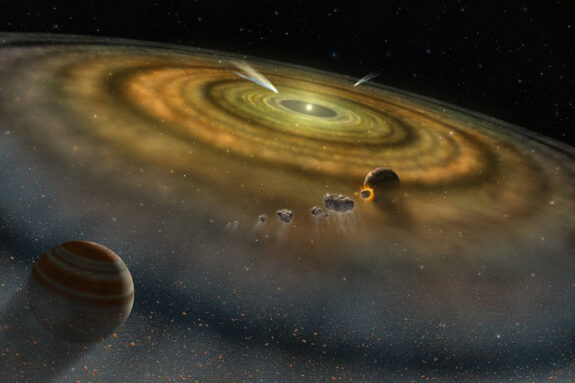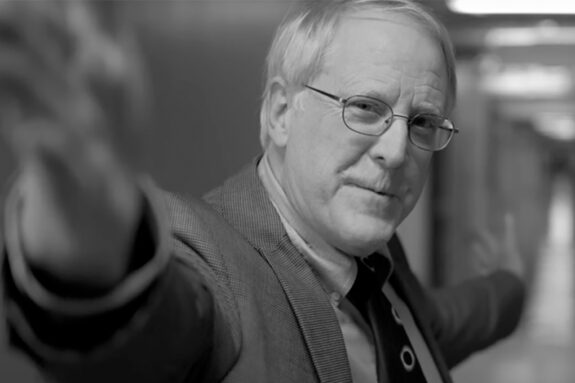Each year, graduating seniors majoring in EAPS present a thesis in completion of their Bachelor of Science Degree. This year we had a class of five students specializing in areas across the Earth, atmospheric and planetary sciences. We asked them about their research, experience in EAPS, and advice for incoming students interested in the geosciences.
Speleothem-Based Hydroclimate Reconstruction of Northeastern Mexico Across the Last Deglaciation
Aviva Intveld (advisor Prof. David McGee)
Summary of Research
My thesis uses calcitic cave sediments to reconstruct changes in local water balance in Northeastern Mexico over the last 22,000 years. I use hydroclimate proxies (stable isotopes and trace elements) to identify “wetter” and “drier” periods over time, and I then explore what these hydroclimate responses can tell us about the underlying climate forcings in the region. My results are helpful both to inform more accurate climate predictions of regional drying and to provide a climatic background for the first peopling of the Americas.
Next Steps?
Next year I will be pursuing an MPhil at the University of Cambridge as a Gates-Cambridge Scholar. I will be working with Dr. David Hodell on human-climate-environment interactions in the lowlands of the Northern Yucatán. (I am still working on the punchline for my “mexican-paleoclimate-with-david-in-cambridge to mexican-paleoclimate-with-david-in-cambridge pipeline” joke)
What was your favorite EAPS class and why?
My favorite EAPS class was 12.108, Structure of Earth Materials. It gave me a solid foundation in mineralogy that has proven extremely helpful in understanding many of my research projects at a microscopic and chemical level. It also sparked a love for thin sectioning that has since bled into my other academic interests. Plus I really loved getting closer to my peers through it!
What piece of wisdom can you share with incoming students?
A big part of my EAPS experience was studying abroad in the UK for a semester through the Royal School of Mines exchange with Imperial College London. I highly recommend future EAPS students consider studying abroad – I took really cool and useful classes, did field work in Sardinia, and expanded my view on my career options and goals. Take advantage of every opportunity you have to travel and broaden your perspective!
Read Aviva’s MIT News Profile to learn more about her research on and off campus.

Near-Infrared Spectroscopy of Near-Earth Asteroids: 3122 Florence, (357439) 2004 BL86, 1036 Ganymed, and 4055 Magellan
Skylar Larsen (advisor Prof. Richard P. Binzel, Dr. Driss Takir (NASA))
Summary of research
The near-Infrared spectra of four near-Earth asteroids, 3122 Florence, (357439) 2004 BL86, 1036 Ganymed, and 4055 Magellan, were analyzed for traces of surface water. The Infrared Telescope Facility (IRTF), located at Mauna Kea, Hawaii, was used to measure long wavelength cross-dispersed (LXD) spectra of these four asteroids with SpeX mode. The measured spectra wavelength ranged from 1.67-4.2 \textmu m, which includes the 3-\textmu m feature attributed to water/hydroxyl. The 3\textmu m spectral feature was found on Florence, but not on 2004 BL86; meanwhile, the Ganymed and Magellan results were inconclusive. Discovering water on a celestial body such as Florence, an S-type asteroid, is highly unusual and warrants further study.
Next Steps?
I am ecstatic to report that I have been accepted to Cornell University’s Department of Astronomy. Over the next 6 years, I hope to research exoplanets and astrobiology as I earn my Ph.D.
What was your favorite EAPS class and why?
12.410, Observational Techniques of Optical Astronomy! Even if I took it remotely because of COVID, I didn’t just learn astronomy facts— I also got hands-on research experience. This means data collection, proposals, presentations, long nights, the whole shebang. Some of the most rewarding work I’ve done at MIT, and it was the class that most prepared me for my future work.
What piece of wisdom can you share with incoming students?
Never be afraid to ask for help. Plenty of bright-eyed freshmen who sailed through their high school classes start their college careers thinking they can handle MIT on their own. This place will beat you to the ground if you’re that overconfident! But in my opinion, the difficulty is intentional, in a way— it is designed to make you reach out and ask your peers, your professors, your TAs, your communities for guidance. I’ve made some of my closest friends by reaching out, and I’m sure you will too.
Read Skylar’s MIT News Profile to learn more about her research and artistic endeavors.

Investigating Launch Vehicle Emissions Impact Variation by Launch Latitude and Season
Helena McDonald (advisors Dr. Sebastian Eastham (MIT Joint Program on the Science and Policy of Global Change, CGCS), Prof. Noelle Selin)
Summary of Research
Using the GEOS-Chem High-Performance atmospheric chemistry simulation, I explore the difference between launch vehicle emissions impact on the atmosphere when launches occur in the Northern versus Southern hemisphere, and summer versus winter.
Next steps?
Two Masters degrees, in EAPS and Technology Policy at MIT.
What was your favorite EAPS class and why?
12.411 Astronomy Field Camp, no question. The opportunity to take part in real research, practice my observational astronomy, and explore a new country all at the same time was incredible. It was definitely a trial-by-fire kind of experience, with long observing nights (up to 15 hours in the telescope at once!) and a very erratic sleep schedule, but I wouldn’t trade it for anything. There’s no experience like standing on top of a mountain on a clear night, looking up at the stars.
What piece of wisdom can you share with incoming students?
Try a little bit of everything; you’ll never know what sticks. I did most of my degree fully focused on planetary science and astronomy, but exploring my climate and policy interests a bit more helped me find the MIT Climate and Sustainability Consortium (MCSC), my current lab, and a line of work I truly love.
Photometric Explorations of Volatile Shifts on Pluto’s Surface
Claire McLellan-Cassivi (advisor Dr. Michael Person)
Summary of Research
For my thesis, I spent a summer at MIT’s Wallace Astrophysical Observatory (WAO), taking data on Pluto with the rest of the UROP students at WAO. I then turned this data into light curves – where the brightness/magnitude is plotted against the longitude on Pluto – to compare to previous observations of Pluto. The goal was to see if there was any difference since around the time of the New Horizons mission, as this would point to the volatile ices on Pluto’s surface migrating. The data point to a shift in the ice of the brightest part of Pluto, the Tombaugh Region.
Outside of my thesis, I am studying asteroids with Dr. Stephen Slivan – primarily those in the Koronis family.
For the research on Pluto, the next step is to take more data and more high-quality data. The UROP students at Wallace this summer will be continuing the project, and I’m excited to see what the results from the next summer’s worth of data will show!
Next Steps?
For myself, my next step is to finish my double major. I added an EAPS major in the second semester of my junior year, and I’ve been working on completing both the Aerospace Engineering (16) and EAPS requirements. Due to the late adding of my double major, I have to take an extra semester to be able to fit all the courses in! After I get my degree, I want to continue studying astronomy and planetary science in grad school.
What was your favorite EAPS class and why?
My favorite EAPS class was, without a doubt, 12.410. I think that class has taught me so much – I’ve learned about astronomy, as well as how to plan and execute observations, and how to communicate the results of the observations. It’s immensely fun, and the work is rewarding. My final project (which was on observations I had taken of open clusters) for that class was the longest thing I had ever written for a class, before I did my thesis of course! It felt so amazing to be able to turn in a massive project on the work that I had personally done, and to present it to a room full of my friends and peers – it was good practice for my thesis! Additionally, taking 12.410 allowed me to take 12.411 – Astronomy Field Camp – which was another highly worthwhile experience.
What piece of wisdom can you share with incoming students?
Don’t think that you’ve run out of time to explore something you’re interested in, even late in your time here! I had only taken 1 class in 12 (12.409, another class I highly recommend) before my junior spring. And now I’ve written a thesis about Pluto!

A Microbial Survey of Lake Kivu
Kaitlyn Przydzial (advisors Prof. Roger Summons and Dr. Ben Uveges)
Summary of Research
I’m working with sediments collected a few years ago from Lake Kivu, a meromictic lake in Africa. We’re studying the lake as an analogue for Ocean Anoxic Events and are trying to better understand the mechanism behind the δ15N excursions observed in the sediment samples. Specifically, I’m using mass spectrometry to identify biomarkers present in the samples and hopefully learn something about the microbial community around the excursion.
Next Steps?
I’ll be going to Germany in the fall to work in an environmental microbiology lab and will also be applying to graduate programs.
What was your favorite EAPS class and why?
It’s really hard to choose so I won’t — it’s a tie between 12.115, 12.178, and 12.S492. All of those classes taught me really valuable skills that are directly applicable to the sort of work I want to do in grad school. Plus two of them involve field work, which is one of my favorite parts of being an EAPS major (what better way to make friends than by camping together in the middle of a desert for three weeks?).
What piece of wisdom can you share with incoming students?
Ask questions! At MIT, it’s really common to feel like you’re constantly playing catch-up but try not to feel bad about asking for help when you don’t understand something. You’re surrounded by students and faculty who are at the top of their fields — learn from them!




